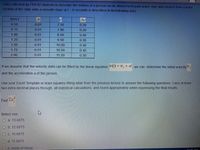Question

Transcribed Image Text:Data collected by PH210 students to describe the motion of a person on an amusement park water slide who moved from a level
section of the slide onto a smooth slope at t= 0 seconds is described in thefollowing data.
(sec)
Su
0.50
0.01
7.10
0.20
0.75
0.01
7.90
0.20
1.00
0.01
8.50
0.40
1.25
0.01
9.50
0.30
1.50
0.01
10.00
0.40
1.75
0.01
10.50
0.40
2.00
0.01
11.20
0.30
If we assume that the velocity data can be fitted by the linear equation: Ut) = v, + at
we can determine the initial velocity U,
and the acceleration a of the person.
Use your Excel Template or least squares fitting table from the previous lecture to answer the following questions. Carry at least
two extra decimal places through all statistical calculations, and round appropriately when expressing the final results.
Find Ex
Select one:
O a. 13.6875
O b. 12.6875
O C. 10.6875
O d. 11.6875
O e. none of these
Expert Solution
This question has been solved!
Explore an expertly crafted, step-by-step solution for a thorough understanding of key concepts.
This is a popular solution
Trending nowThis is a popular solution!
Step by stepSolved in 2 steps with 1 images

Knowledge Booster
Similar questions
- x+2 If y = what is the value of y when x = 5i? 6-7 61 13 61; 40 61 13 + 0i 40 61 40 61 13 61arrow_forward6. A student measured the horizontal and vertical components of the velocity of a projectile in a laboratory situation. The data is given below. Times and velocities are "true" (not scaled). Time, t(s) 0.10 2.12 0.20 2.12 0.30 2.13 0.40 2.11 0.50 2.12 (a) Plot vertical velocity vs. time. Horizontal velocity, v (m/s) Vertical velocity, v (m/s) 3.58 4.56 5.54 6.52 7.50 PREVIEW (b) Find the slope and y-intercept of your graph. (c) Write an equation specifically describing your graph. (d) On same graph sheet, plot horizontal velocity vs. time. (e) Write an equation specifically describing your second graph.arrow_forwardA guided missile is propelled from the origin of a coordinate system with the x-axis along the ground and the y-axis vertical. Its path, or trajectory, is given by the equation y = 464x − 16x2. Find the object's maximum height. Answer in unitsarrow_forward
- Find the magnitudes of velocities v VA and v VB + y A XX V tot 0 VB in the figure below, where, 0 = 22.5⁰ and Vtot = 7.28 m/s. 23.0% 26.5° VA Vtot = VA + VB VB Xarrow_forwardFind the components of tot along the x and y axes in the figure below, where 8 = 21.0° and tot Vtot, x V tot, y = = + Vtot = VA + VB УА VB A Vtot 26.5° 23.0% VA X = 7.60 m/s.arrow_forwardPart (a) Do this for the range r > R. E = _____ Part (b) Do this for the range r < R. E = _____arrow_forward
- 7) An object has an initial velocity v, = 4î +5ĵ m/s. After 10 seconds of motion, its velocity %3D was found to be v, =-6i +15j. The average acceleration is: %3Darrow_forward15 25 30 35 50 60 (sec) v(1) (f/sec) -20 -30 -20 -14 -10 10 a(t) 2 2. 4 (1/sec") A car travels on a straight track. During the time interval 0sts 60 seconds, the car's velocity v, measured in feet per second, and acceleration a, measured in feet per second per second, are continuous functions. The table above shows selected values of these functions. а, For 0arrow_forward
arrow_back_ios
arrow_forward_ios